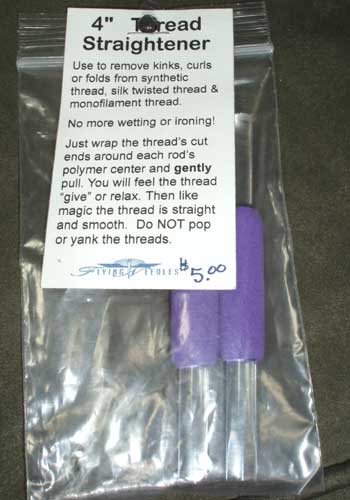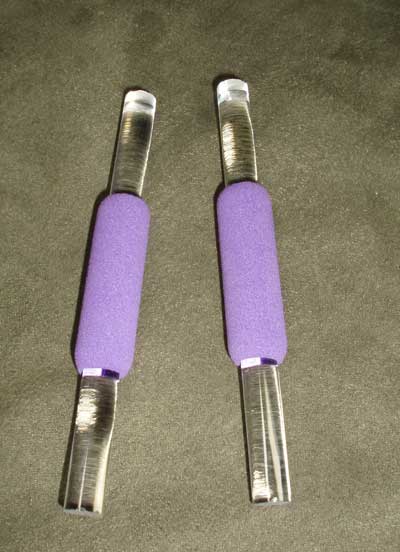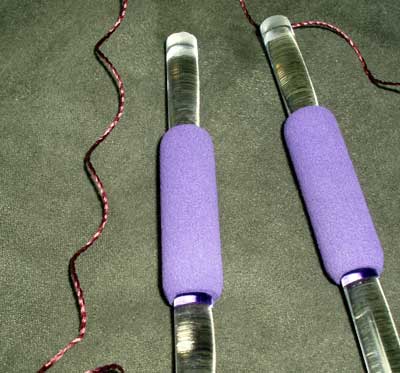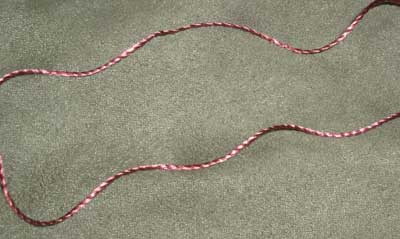A couple weeks ago, I took my Mom to a small cross stitch shop here in Kansas. She was looking for some kind of magnetic something-or-other to mark her filet lace crochet patterns, and I was happy to oblige her with the journey – I’m always in the mood for a needlework shop, after all! While we were there, I came across an interesting “tool” that captured my interest, so I bought it, thinking (if it does what it says) it would be an interesting tool to share with you.
But as it turns out, I am majorly perplexed by this needlework tool. Maybe someone out there can enlighten me on its value!

This is what it is: “thread straightener” rods, for silk or synthetic threads that are kinky, curly, etc.
Now, in concept, I am not opposed to a tool that would easily assist in relaxing the kinks out of silk threads. I, too, have been befuddled and frustrated by silk threads that are so boingy that they are a pain to use.
So I was more than willing to give this little miracle tool set a try.

These are two four-inch plexi-glass or pastic dowels, with a purple rubbery foam cushion hugging the middle of the dowels. The purple stuff feels a lot like the stuff that’s used on the outside of drink bottles to insulate them.

According to the directions, you’re supposed to wrap the cut ends of each thread around the purple foam center, and gently pull until you feel the thread relax. This is supposed to remove kinks, curls, etc.
For my first attempt, I took out some curly silk that was wound on a small, narrow spool, so it was a bit out the curly-bouncy side. I wrapped only the cut ends (about an inch or an inch and a half) around the purple stuff, one end to each dowel. And I pulled gently.
What I felt was the cut ends sinking into the foam center on the dowels. I didn’t “feel” the thread relax. ??!! And the thread didn’t look any different when I removed the ends from the dowels, except that the ends were a bit staticky.
Then I looked at the instructions again, and I thought that perhaps they really meant that, starting from each cut end of the thread, I was to wrap the thread all the way around the purple foam, into the center of the thread, so that the thread was wound onto the dowels, and then I was supposed to pull gently, pulling the thread off the dowels.

So I tried that, too, and ended up with a staticky mess of curly silk thread. I’m assuming my second interpretation of the directions was entirely incorrect – curly-boingy thread is one thing. Staticky-curly-boingy thread is another matter entirely, and practically impossible to stitch with.
Yes, I’m stumped. This isn’t exactly my idea of a useful needlework tool. But perhaps I’ve got the whole thing figured wrong, and there’s some way to make this $5 set of 4-inch plastic sticks useful? Any clues?
A tried and true method for relaxing kinked, curly, or bouncy silk thread: Take the whole bundle (assuming it’s coming off a skein) and cut it to your preferred length for stitching. Then put the tea kettle on. Once it starts whistling, hold your bundle of threads in both hands, and pull gently on it while running it through the steam from the kettle. In this way, you’ve relaxed your whole bundle of threads in one go. Then fix yourself a cup of tea and let your threads dry out. You can also use Thread Heaven on particularly cantankerous threads, to good effect.







Well..I know that with suture (for vets and so forth), stretching it DOES remove the kinks etc and makes it MUCH easier to work with. It takes a fair bit of pull and works on silk, gut,monofilament and braided sutures.
Try wrapping around a couple of hemostats (I know you have some there somewhere!) and pulling. Steady firm pull is key.
Never tried it with thread; maybe I should!
I haven't a clue – unless you are supposed to wrap around just the clear part, and leave a tail on the padded part to get a good grip? I'd think that what I've read some beaders do with nymo would be easier – form your thread into a big loop, and hang on a hook and add a weight to the bottom of the loop, and let it hang until you're ready to use.
thanks for the tip on using steam, sounds much more relaxing!
JustGail
What a coincidence. I saw these last week at Joanne's. I was going to buy them but I wasn't sure how well they actually worked. I'd be interested to see what others have to say but this niffty little tool.
Maybe there's a little trick to it.
It looks to me like you are supposed to take a strand of thread and hold the cut ends. wrap one cut end a little on one rod, the other cut end on the other rod, roll them towards each other, like a scroll, and then slowly pull as they unroll! Try it!
Mary wrap each cut edge around the centre of each foam section and pull as if you were straightening beading thread. It is on the flying needles website and it looks like a good idea for more than one type of needlework.
Lol! Well, I've always done this with rayon threads, but never used a fancy tool just my fingers. Just wrap the ends around a finger on each hand and pull. You can definitely feel the thread stretch a bit when you pull on them and it does help straighten the thread out. It's a lot easier to do with the thinner threads (Edmar Glory & Frost) so I guess this tool might be useful for thicker threads that would hurt your fingers if you pulled hard enough to straighten the thread out. I think you were doing it correctly the first time, you just didn't pull hard enough.
-Andrea
Thanks for the input, all! I'm still not quite convinced that the tool is that useful! Still, I'll try everything you suggest.
This isn't necessarily a "negative" review, by the way – it's just a "question mark" review. ??? As Linda said, you can accomplish the same things with your fingers!
I also use the steam method. This tool reminded me of an advertisement in a newspaper many years ago about this wonderful gadget one could order to get rid of flies. When the "gadget" eventually arrived it was two pieces of wood. The instructions were, to wait for a fly to come and sit on the one piece and then you gave it a whack with the other piece. Well someone made some money until he was found out.Elza
I first started using these straighteners with beading thread like Nymo. And have graduated to using them with certain metallic threads. I've never had the need to try them with silk.
You have the correct idea. Cut a length of thread. Wrap cut ends around foam cores and pull. With Nymo I usually pull hard.
these have been arodun for a while – they were in an ANG mag at least over a year ago. i bought them – great for Neon rasy and all those nasty folds that slip out of the needle and show on the canvas. cut your length fo thread, put each end over the cushion of one of the pullers, wrap it up a little on each end and pull softly, not hard like breaking it or tearing it apart, like pulling taffy with each hand holding one of the tools. presto – the folds are gone. never tried it on metallic but the folded flat threads i like the way it straightens them out.
Here is their official web site: http://www.flyingneedlestx.com/threadstraightener.htm
Mary, I usually do the same thing as Andrea for Neon Rays. This was a hint from Carolyn Mitchell in a class I took last year. Just wrap the ends around your index fingers (or the padded centers of your plastic sticks if you don't want to cut off any circulation!), and pull them apart, slowly but firmly. It does take a bit to get the kinks/twists out. If you still have very curly or kinked thread, it wasn't pulled hard enough.
Another tip I use is to run my thread over a hot (dust-free) light bulb. Just try not to look into the light as you do it. Ask me how I know!
Hmmm. I have nothing extra to add to the other ideas. Methinks I will stick to my Thread Heaven, which I couldn't live without! I'll also give your kettle hint a try (if nothing else, it's good for a cuppa, right?)
Mary, website has a picture of how to do it.
Can you inform us again whether this product helps?
I might want to buy it.
vincent
I am a cross stitcher and can't imagine how those foam sticks would help straighten a floss at all. I bought some beautiful EdMar floss and it was like stitching with a Slinky toy. I sent it off to a friend who explained the steam trick, stitched some beautiful flowers for me and sent flowers and floss back to me to try again (thank you Dixie). I think I'd stick with the steam. It's cheaper and you can make some tea at the same time.
Hello Mary, I am a recent follower of that beautiful work of yours.
Concerning that thingy, I would tend to concur with Irene. Steam is cheaper and has a double effect : effect 1 : uncurl the thread – effect 2 : make some tea 🙂
Also, it looks like someone is surfing on the fad for embroidery and all the must-haves of that craft. Do I really need all these lovely little tools that are supposed to make my life (embroidery life, that is) easier ? I don’t think so. But someone sure found a way to make some money on our backs. Also, I am not sure pulling silk that hard would be so good, even filament silk.
Voilà, this is my 2-cents advice that comes a bit late, I know.
Have fun and continue to show us your beautiful work !
It sounds like you were using these the intended way the first time you tried them. The website has a photo and and description that sound like what you did: http://www.flyingneedlestx.com/threadstraightener.htm
Wrapping the thread around your fingers and pulling should work just as well.
I think this is the kind of tool you loss in the bottom of your needle work box and try to forget you spent the money on it. I have my own tool. It's called a steam buddy. a small hand steam machine normally used for travel and such. I love it. I use it for getting the kinks out of thread, removing the marks from using a hoop, smoothing out my embroidery after I have finished with out flattening the stitch's like an iron does, and it even helps to remove some minor dirt marks. and even for tighten up the fabric in the hoop or frame if it come slack. But hay I like the tea idea to.
Dido
Don't know about that tool, but I use the same method I would if I had spun the yarn and now needed to "set" it (relax the yarn or thread now that it is spun and plied). I wet the skein, roll it in a towel to remove the excess water, hang the skein, and weight it. And I move the skein around as it dries so the weight doesn't create a crease by being in the same position while the skein dries. I use this method for all natural fibers.
When using silk or other cording for stringing and knotting pearls or other beads, the cording must be stretched. If not spaces between the pearls and knots develop. So maybe I can use this device for my purpose and prevent my fingers from cuts. Thank you.